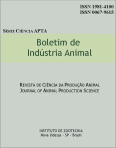Waste compost effect on macronutrients in haplorthox soil
Keywords:
Brachiaria Piatã, biofertilizer, waste compostAbstract
Composting is a controlled aerobic process to treat and stabilize organic wastes, transforming them into organic fertilizers. It is environmentally friendly (by treating polluting wastes and recycling nutrients and materials), sanitary (by breaking the cycle of diseases and eliminating vectors) and socially beneficial (by generating jobs and improving crop yields). The use of compost from urban waste (the product obtained by composting the organic part of solid household wastes) can improve soil fertility without harming the environment. This study aimed to evaluate the effect of levels of organic fertilizer (waste compost - WC) on soil macronutrient contents. The experiment was performed at the Animal Nutrition and Pasture Center €“ Instituto de Zootecnia €“ Nova Odessa, SP, between January and June 2013, in a Haplorthox soil (pHCaCl2= 4.9), cultivated with piatagrass (Brachiaria brizantha, Stapf), without liming. The treatments involved five rates of WC application: 0, 2.0, 4.0, 6.0, 8.0 and 10.0 Mg ha-1, mixed with soil before sowing the grass. The experimental design was randomized blocks, with five replications, in pottery vessels (3.34 dm3). Soil samples were collected prior to the experiment (original soil) and after cultivation of the grass (60 days after application). The samples were air dried and passed through sieves with 2 mm mesh and analyzed chemically. The macronutrients (P, S, in mg kg-1 and K, Ca and Mg mmolc kg-1) were quantified. The method to measure P, Ca, Mg and K was atomic emission spectrophotometry, after extraction with ion exchange resin, and the S concentration was measured by turbidimetry. The data were analyzed by the mixed procedure of SAS V. 9.2. The degrees of freedom related to the five rates (quantitative treatment) were decomposed into orthogonal polynomials to obtain the best equation to fit the data. In the original soil, the concentrations of the macronutrients analyzed were considered low. The application of the WC doses significantly increased the levels of P, S, K and Ca. The following concentration ranges were obtained: P from 6.0 to 29.0, according to the equation P= -0.096WC2 + 5.01WC + 8.30, R2=0.91; S from 7 to 76.0, according to the equation S= 5.6WC + 21.50, R2=0.98; K from 1.2 to 2.02, according to the equation K= 0.099WC + 2.099, R2=0.92; and Ca from 8 to 19.8, according to the equation Ca= 0.58WC +13.52, R2=0.95. However, no significant differences were detected in Mg content, which varied from 3.8 to 5.5. The WC rate of 2.0 Mg ha-1 was sufficient to raise the levels of P, S, Ca and Mg from low to medium or high levels, in all cases not limiting for growth of Brachiaria, but the concentrations of K, although increased by application of the WC, were still under the critical limit, even at the highest WC rate.Downloads
Downloads
Published
Issue
Section
License
Os autores não serão remunerados pela publicação de trabalhos, pois devem abrir mão de seus direitos autorais em favor deste periódico. Por outro lado, os autores ficam autorizados a publicar seus artigos, simultaneamente, em repositórios da instituição de sua origem, desde que citada a fonte da publicação original seja Boletim de Indústria Animal. A revista se reserva o direito de efetuar, nos originais, alterações de ordem normativa, ortográfica e gramatical, com vistas a manter o padrão culto da língua e a credibilidade do veículo. Respeitará, no entanto, o estilo de escrever dos autores. Alterações, correções ou sugestões de ordem conceitual serão encaminhadas aos autores, quando necessário. Nesses casos, os artigos, depois de adequados, deverão ser submetidos a nova apreciação. As opiniões emitidas pelos autores dos artigos são de sua exclusiva responsabilidade. Todo o conteúdo deste periódico, exceto onde está identificado, está licenciado sob a Licença Creative Commons Attribution (CC-BY-NC). A condição BY implica que os licenciados podem copiar, distribuir, exibir e executar a obra e fazer trabalhos derivados com base em que só se dão o autor ou licenciante os créditos na forma especificada por estes. A cláusula NC significa que os licenciados podem copiar, distribuir, exibir e executar a obra e fazer trabalhos derivados com base apenas para fins não comerciais.













